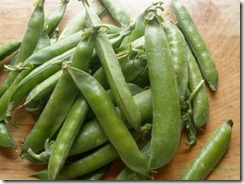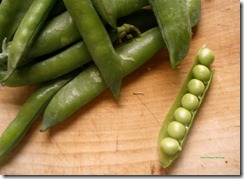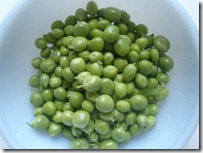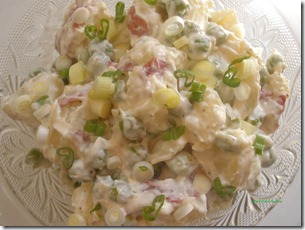

The 2011 growing season seems to be shaping up nicely, with more, earlier—two good things—than expected. There have already been wonderful snap peas, so sweet and crisp-tender that I have been eating them raw more often than not; and now there are elegant, slim green beans and the paradoxically much maligned and much beloved English or garden pea. Today we will consider the pea.
I am not really sure why they are called English peas, because they are not native there and they have other common names, like garden or shell pea. But most of us just call these “peas” and everyone knows what we are talking about. Peas are high in protein and vitamin C—perhaps the reason children are always being admonished to finish them. They are eaten fresh with surprising rarity, in part because of their short season (they don’t like the heat) but mostly—given the now year-round availability of nearly everything, including other kinds of peas—because their sweet tenderness quickly turns to mealy toughness; they don’t travel well. They are like corn in this regard. As a result, only about 5% of all peas are sold fresh. Most peas are frozen (or canned), and fresh-frozen peas are one of the very few frozen items I ever buy. But if you see them fresh I recommend them, because they really are different when cooked because they can still be eaten crisp. I wouldn’t buy them fresh-shelled, which you sometimes see at good markets or farmers markets, unless you can confirm they were shelled TODAY. Otherwise, you are throwing that high price that you just paid away.
The shelling, in my opinion, is no big deal, and has its own pleasures. Holding them over a bowl, pull from the stem end and pop them open along the seam: the peas will come tumbling out with the gentlest brush of a finger. This is an excellent activity to do with a toddler as it doubles as a game and lesson in learning to count, and also in nature’s variety. How many peas inside? 5, 6, 7, 8? Today I had one pea with 10—a record. It is delightfully unpredictable, as there seems to be a rather imperfect correlation between pod size and pea count. The peas are shiny and pretty; pop one of these spherical seeds in your mouth. Apparently, the act of shelling peas is arousing as well; who knew? In the late 19th century, Harry Breaker Morant wrote in his poem A-shelling Peas:
Old earth owns many sights to see
That captivate and please; -
The most bewitching sight for me
Is Nell a-shelling peas.
This year’s peas have arrived on schedule, in time for the 4th of July, when they have a long and venerable tradition on the New England table. One would scarcely know that nowadays by looking at the typical 4th of July repast: burgers and dogs, lobster rolls, or ribs and pulled pork do not exactly shout “peas!” for a side dish. But of course, burgers and dogs, lobster rolls, and ribs and pulled pork did not used to be traditional in New England. Poached salmon was. And that was accompanied by boiled potatoes and English peas, and some sort of lemony sauce. Devotee of old traditions that I am, I used to make this myself every year. But frankly, I am not a huge fan of salmon, and who really wants to eat hot side dishes with cold food? For the 4th, I like a good burger, or some grilled (or fried) scallops. And some potato salad.
So have whatever you want (it is, after all, Independence Day), but do mind your peas.
Fourth of July Potato and Pea Salad
This is more the colors of the Mexican than the American flag, but its 4th of July credentials are true-blue. The garlicky mayonnaise sauce bears some resemblance in flavor to aioli, which you could use, but this is lighter and more subtle. And has the lemon. Serves 2-3.

1 lb small red-skin potatoes
1 cup shelled fresh English peas
½ c homemade or good-quality commercial mayonnaise such as Hellman’s®
1 tea extra-virgin olive oil
1-2 large, fresh garlic clove, peeled and smashed
2 T fresh-squeezed lemon juice (about ½ large lemon)
1/8 tea salt
7 or 8 twists of freshly ground black pepper
1 scallion, finely sliced, for garnish
Shell the peas as soon before cooking as possible. Blanch them in boiling water for about 3 minutes; do not overcook. Pour into a strainer, run cold water over, and let drain thoroughly.
Cut the potatoes in half (quarters if large) and boil until tender; they will slide off a knife inserted in the center, but will not fall apart. Depending on the size and age of your potatoes, this could take 15-25 minutes.
While the potatoes are cooking, put the mayonnaise in a bowl and add the whole smashed garlic clove(s), salt, and pepper; stir and set aside for at least 20 minutes.
Drain the potatoes. Fish out the garlic from the mayonnaise. Add the 2 T of lemon juice; it is a lot, and you can use less if you want, but I like it for this. The mayonnaise will thin considerably. When the potatoes are cool enough to handle but still warm, slice them into the sauce, and toss gently with a wooden spoon or rubber spatula. Add the peas and toss. It will be saucy, suitable for accompanying poached or grilled fish or shellfish. Or burgers.
Let sit on the counter for 30 minutes or so before serving; to repeat my mantra: do not refrigerate. Just before serving, taste for seasoning, adding additional salt and pepper to taste, and sprinkle with the scallion and/or, if you wish, finely minced parsley or a little mint. Refrigerate any leftovers and bring to cool room temperature again before eating; the peas will have lost some of their bright green color from the acid.


No comments:
Post a Comment